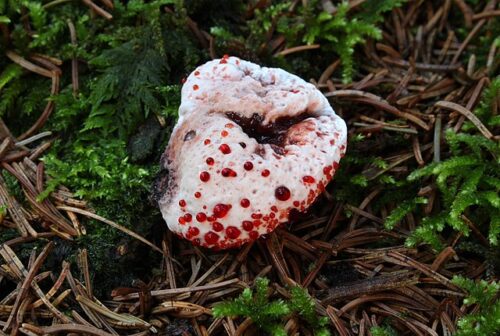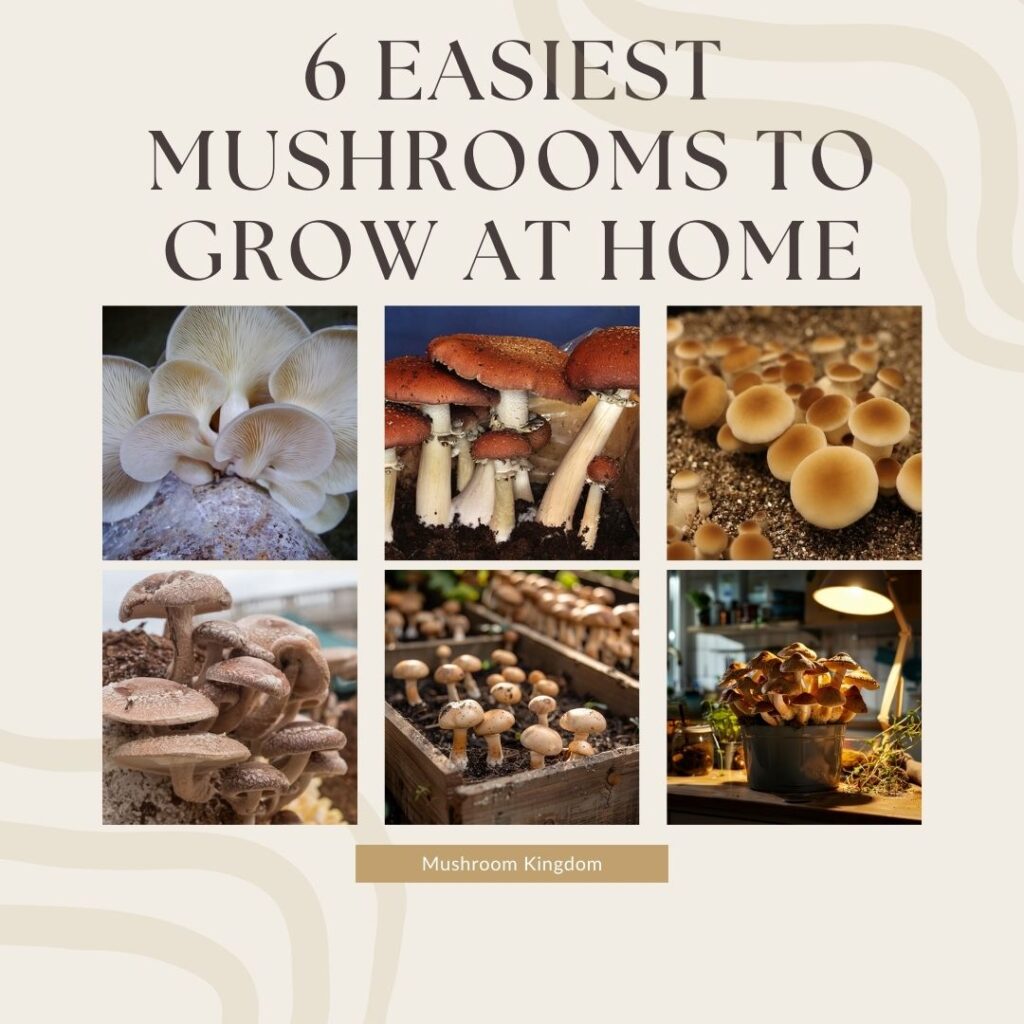The Devil’s Tooth mushroom belongs to the family Bankeraceae and the genus Hydnellum. It is characterized by its spiny or tooth-like underside, which distinguishes it from mushrooms with traditional gills or pores.
How To Identify Hydnellum Peckii (Devil’s tooth) Mushroom?
Here are the steps to accurately identify this unique and striking fungus:

Cap Appearance
Young Cap: When the mushroom is young, the cap is predominantly white to cream-colored. This is when the mushroom is most striking, especially with the presence of red fluid.
Mature Cap: As the mushroom ages, the cap darkens to shades of brown or tan. The texture of the cap is rough and bumpy, contributing to its unique appearance.
Red Fluid: One of the most distinctive features of Hydnellum peckii is the red fluid that exudes from the cap when the mushroom is young. This fluid forms droplets on the surface, giving the mushroom a “bleeding” appearance. This feature not only makes it easily recognizable but also quite striking and somewhat eerie.
Spines
Instead of the gills seen in many other mushrooms, Hydnellum peckii has spines or tooth-like projections on the underside of its cap. These spines are where the spores are produced and released.

The spines are white to pinkish when the mushroom is young, which may turn to a duller color as the mushroom ages. The spines add to the overall rough texture of the mushroom.
Stalk (Stem)
The stem of Hydnellum peckii is short and thick, often stout in comparison to the cap’s diameter. It is usually the same color as the cap, making it less distinct.
Also, similar to the cap, the stem has a rough texture, which can be covered with fine hairs or scales.
Habitat
This mushroom typically grows in coniferous forests. You can often find it among mosses and leaf litter, thriving in the shaded, moist environment provided by the forest floor.
Also, it forms symbiotic relationships with trees, particularly conifers. It attaches to the roots of the trees and exchanges nutrients, which is beneficial for both the fungus and the tree.
In terms of geographical distribution, it mainly grows in North America and Europe. In these regions, it prefers acidic soil environments, which are common in coniferous forests.
Size
The cap typically ranges from 5 to 15 cm in diameter. This size can vary depending on environmental conditions and the age of the mushroom.
Including the stem, the mushroom can grow up to about 10 cm tall. The stem is usually relatively short in comparison to the cap.
Spore Print
To obtain a spore print, place the cap gills or spines down on a piece of paper and leave it for several hours or overnight. The spores will drop onto the paper, revealing their color. The spore print of Hydnellum peckii is brown, which can help distinguish it from other similar-looking mushrooms.
Smell
Hydnellum peckii has a mild to the slightly unpleasant odor. While the smell is not as distinctive as the visual characteristics, it can be a helpful identifying feature when combined with other traits.
Is Hydnellum Peckii (Devil’s tooth) Edible?
Devil’s Tooth mushroom, is not edible. Firstly, the mushroom has a very bitter taste, making it unpalatable. Even if it were safe to eat, the bitterness would deter most people from consuming it.
Next, it has a tough, woody texture. This characteristic makes it difficult to chew and digest, further reducing its appeal as a food source.
On top of that, this mushroom does not offer significant nutritional benefits or desirable culinary properties. Instead, foragers and chefs tend to focus on mushrooms that provide better taste, texture, and nutritional value.
In general, Hydnellum peckii is primarily appreciated for its unique and striking appearance. The “bleeding” red droplets on its cap make it a fascinating subject for mycologists and nature enthusiasts. Its aesthetic value far outweighs any potential use as an edible mushroom.
What Happens If You Eat Devil’s Tooth Mushroom?
Consuming the Devil’s Tooth mushroom can lead to various adverse effects due to its bitter taste and potential toxicity.
In general, devil’s tooth mushroom is not toxic or poisonous. But, experts do not recommend it for consumption due to its extremely bitter taste and tough texture.
One of the most common consequences of consuming the Devil’s Tooth mushroom is gastrointestinal discomfort. This may include symptoms such as:
- nausea
- vomiting
- abdominal pain
- diarrhea.
These effects can range from mild to severe, depending on the individual’s sensitivity and the amount ingested.
Also, some individuals may experience allergic reactions to certain components of the Devil’s Tooth mushroom. These reactions can vary in severity and may include symptoms such as itching, hives, swelling, or difficulty breathing.
Hydnellum peckii Mushroom Etymology
The common name “Devil’s Tooth” likely originates from the mushroom’s appearance, particularly its tooth-like projections on the underside of the cap, which gives it a distinctive and somewhat sinister look.
These spines or teeth, where the spores are produced, resemble a toothy grin, contributing to the association with the “devil.” Additionally, the presence of bright red droplets on the cap, resembling blood, may have further cemented this connection.
The genus name “Hydnellum” derives from the Greek word “hydnon,” meaning “truffle” or “tuber,” likely referring to the mushroom’s underground mycelium or its subterranean growth habits, reminiscent of truffles. However, unlike truffles, Hydnellum species are not valued as culinary delicacies.
The species epithet “peckii” honors the American mycologist Charles Horton Peck (1833–1917), who made significant contributions to the study of North American fungi. Peck described numerous fungal species during his career, and Hydnellum peckii was named in his honor by American mycologist Howard James Banker in 1913.
Interesting Facts about Devil’s Tooth Mushroom
One of the most distinctive features of the Devil’s Tooth mushroom is its tendency to “bleed” a bright red fluid when young or moist.
These droplets give the mushroom a striking appearance, often likened to blood oozing from a wound. This unique characteristic has earned it various nicknames, including the Bleeding Tooth fungus.


